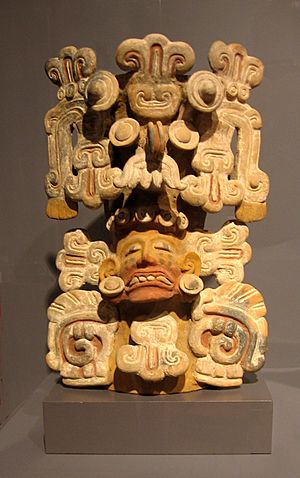Purépecha religion facts for kids

The Purépecha religion was the main set of beliefs and practices of the Purépecha people. They were a powerful group in ancient Mexico. Their religion was very important to their daily lives and how they understood the world. It helped shape their culture, government, and art.
Contents
Understanding Purépecha Religion
The Purépecha religion was a complex system of beliefs. It included many gods and goddesses. These deities were linked to nature, the sky, and human activities. The Purépecha people believed that these gods controlled everything. This included the weather, harvests, and even war. Their religion also had special rituals and ceremonies. These events were held to honor the gods and ask for their help.
Who Were the Purépecha?
The Purépecha people lived in what is now the Mexican state of Michoacán. They built a strong empire called the Purépecha Empire. This empire existed from about 1350 CE until 1521 CE. It was one of the largest and most powerful empires in Mesoamerica. They were skilled warriors and craftspeople. Their capital city was Tzintzuntzan. The Purépecha were known for their metalwork, especially with copper. Their religion was central to their identity.
Main Gods and Beliefs
The Purépecha had a rich mythology. They believed in a world with different levels. The gods lived in the upper levels. Humans lived in the middle world. The underworld was for the dead. Their main gods represented important natural forces.
Curicaueri: The Sun God
Curicaueri was the most important god. He was the god of the sun and fire. He also represented war and the male principle. The Purépecha believed he created the world. He gave them warmth and light. Temples dedicated to Curicaueri were often built on high places. Priests would make offerings to him. These offerings included blood sacrifices. They believed this would keep the sun strong.
Cuerauáperi: The Mother Goddess
Cuerauáperi was another very important deity. She was the goddess of creation and the moon. She was also linked to rain, fertility, and the earth. The Purépecha believed she brought life and helped crops grow. She was seen as the mother of all gods. People prayed to her for good harvests. They also asked for healthy children.
Xaratanga: The Star Goddess
Xaratanga was the goddess of the sea and stars. She was also associated with the west. She was sometimes seen as a sister or daughter of Cuerauáperi. Her role was important for fishing communities. She also guided travelers by night.
Other Important Deities
The Purépecha worshipped many other gods. These included gods of the wind, maize, and death. Each god had a specific role. They were honored in different ways. Priests played a key role in connecting people to the gods.
Important Rituals and Ceremonies
Religious rituals were a big part of Purépecha life. These ceremonies often involved music, dance, and special clothing. They were held at specific times of the year. This was often linked to agricultural cycles.
Offerings and Sacrifices
Offerings were made to the gods regularly. These could include food, precious stones, and incense. Sometimes, animal sacrifices were performed. In some cases, human sacrifices were also part of their rituals. These were done to please the gods. They believed it would ensure the well-being of the community.
Priests and Temples
Priests were very powerful in Purépecha society. They were responsible for leading ceremonies. They also interpreted messages from the gods. Temples were sacred places. They were built in important cities like Tzintzuntzan. These temples were often pyramid-shaped. They had platforms called yácatas.
The Impact of the Spanish Conquest
When the Spanish arrived in 1521, they conquered the Purépecha Empire. The Spanish brought their own religion, Christianity. They tried to convert the Purépecha people. Many temples were destroyed. New churches were built in their place. Over time, many Purépecha people adopted Christianity. However, some of their ancient beliefs and practices continued. They blended with Christian traditions. This created a unique mix of old and new beliefs.
Today, some Purépecha traditions still exist. They show the lasting influence of their ancient religion. These traditions are often seen in festivals and local customs.

